Genuine or spurious? - The Parts Conundrum
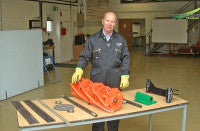
Why Genuine Parts?
There's nothing new about this statement. It has been a contentious issue for years, in many industries, as well as our own turf care sector. We all know the arguments for and against; price, warranty, correct fit first time or not, longer lasting or not etc. etc.
Products within the Ransomes portfolio are, more often than not, used in the harsh commercial mowing sector and are being used on roadside verges, housing areas, parks and open spaces. These sometimes hostile environments create high wear on cylinders, bottom blades, lift arms, pivot shafts and other associated components.
So, what of the issue of price over quality?

The usual discussion of genuine versus non genuine goes along the lines of; "the non genuine costs less"; reply, "does it last as long?" The response; "no, but it costs less".
What is not taken into account at the time of purchase is that the user will almost certainly face a bottom blade change part way into the season with the non genuine blade, requiring the
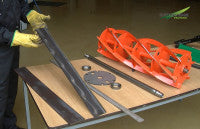
Of course, the cutting cylinder is the other crucial part to the cutting unit and also becomes part of this debate. What is often overlooked is that the manufacture of these two items, and the materials used, has been developed and refined over 182 years of manufacturing cylinders and blades here in Ipswich. This ensures that they function together for maximum cutting efficiency, durability and longevity.

Let's look at the 30" bottom blade and its manufacture at Ipswich. Flat steel plate is loaded into an oven and brought to the relevant temperature. One at a time, the flat plates are removed, placed in a 250 tonne press and the lip is formed that will become the cutting edge of the blade.
The newly formed blade is returned to the oven in order to relieve stress, and allowed to cool naturally before being shot blasted. Excess material is then machined from the top of the blade lip.
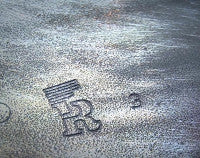
The remaining processes are blade straightening, jig drilling (on a multi spindle drill to ensure hole positioning accuracy), grinding of the cutting edge surface, stamping with the Genuine Parts 'R' and then coating with oil before sending to parts inventory.
That's only the bottom blade, so what of the cutting cylinder?
Cylinder manufacture
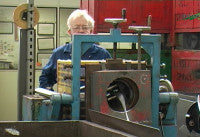
The next operation is to build up a cylinder on a dummy spindle. The relevant collars are positioned on the spindle with removable spacers in between. Spiral blades are the fitted into the slots in the collars and held tightly in place by steel banding wrapped around the cylinder assembly. Skilled welders spot weld at every point where the spiral blades fit into the collars.
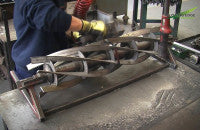
Next, the relevant spindle and bearing cups are welded in place, weld spatter removed and the cylinder assembly checked for concentricity. Powder paint is electro-statically applied to the cylinder following a chemical wash and drying process to remove all contamination. The powder melts when passing through the paint oven and, once cool, the cylinders are spun ground to provide their cutting edge.
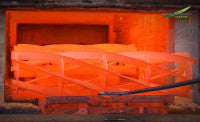
During all these processes of both bottom blade and cylinder manufacture, there are constant checks to ensure that the high quality built into the manufacturing of the items is maintained.
Damage prevention
Yes, they may be a slightly more expensive to purchase in the short term? However, superior performance and longevity reduces costs in the long term.

This protects other components on the mower from being damaged. A pivot shaft that is too hard can snap causing the unit to fall off the machine; if too strong, then the impact damage is transferred elsewhere to a more expensive lift arm perhaps or pivot bracket assembly on top of the cutting unit.
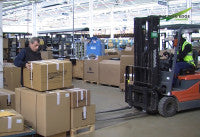
Rollers
The same 'genuine' argument applies to rollers; a zinc coating helps with salt resistance, the swaged, rounded ends help minimise turf damage when turning and they are covered by a one year warranty for manufacturing or material defects. They are specifically manufactured to match the performance of product.
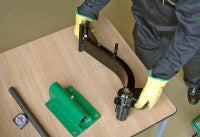
What about warranty on genuine parts? Yes, at Ransomes Jacobsen we offer one year, subject to fair wear and tear.
There are other parts associated with machinery, such as filters, tyres and wear skids, all of which need looking at carefully before buying the cheapest.
Final thought
And, one final thought. The ever increasing pressure on employers to control and measure Hand and Arm Vibration (HAV) levels, beyond the supply of machines when new, presents some difficult questions moving forward.
For example, let us look at a hypothetical ride-on mower which is three years old and has measurements being taken for HAVs. The findings are higher than the manufacturer's original statement, so the first remedial action is to contact the manufacturer and ask what can be done.
Without doubt, the first and most obvious question will be; is the machine to the manufacturer's original specification and fitted with genuine parts?
Genuine versus non-genuine will always be a contentious issue but, is a short-term gain preferable to increased costs further down the line. That's the call you have to make but, remember, non-genuine parts may not reduce your maintenance costs in the long term.
Summary

Genuine parts will keep your machine working to the same high standards as new; their longer lasting performance should equate to cost savings in the long-term and they are British manufactured to the strict quality standard BSEN836.
